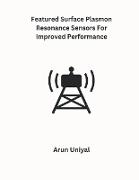- Start
- Featured Surface Plasmon Resonance Sensors For Improved Performance
Featured Surface Plasmon Resonance Sensors For Improved Performance
Angebote / Angebote:
The last four decades have shown rapid advancement in sensing techniques, photonics, and optoelectronics devices. Various sensing techniques, such as optical, electrical, mechanical, and piezoelectric, are available. The optical biosensor is a popular candidate for detecting and examining molecular interactions from the last decades (Cooper, 2002, Bhalla et al., 2016). Firstly, the optical biosensor was introduced in 1980s (Cooper, 2002). Variations in the electromagnetic (EM) fields or light intensity due to the samples present have been done using Optical sensors. Optical sensing methods like SPR, surface-enhanced Raman scattering (SERS) spectroscopy, micro ring resonators, and fiber gratings are few optical sensing techniques (Ajad et al., 2021, Damborsky et al., 2016, Homola et al., 1999, Kersey et al., 1997). With great sensitivity and a diverse set of applications, SPR sensors have drew attention among all sensing technologies. This optical method examines the refractive index (RI) changes because of bio- molecular interactions near nano-scale metal layers (such as gold-Au, silver-Ag, aluminium-Al, and nickel-Ni films). SPR sensors used for bio sensing, such as the detection of proteins, enzymes, and drugs (Masson, 2017), physical quantities measurements such as monitoring of magnetic field (Mo et al., 2021), temperature (Mo et al., 2021), humidity (Zhu et al., 2018), and environment monitoring (Homola, 2008), have been carried out by many researchers in their work. Photodetectors are significant photonic devices for use in various domains, such as optical communication (Fama et al., 2002), biological imaging (Puiu & Bala, 2016), and defense. Initially, The concept of surface plasmons (SPs) was introduced by Ritchie in 1957 (Ritchie, 1956). In 1968, Otto proposed a prism-relied SPR configuration which uses the mechanism of the attenuated total reflection (ATR) principle (Otto, 1968). In this approach, a finite air gap exists in the interface of the coupling prism and the metallic layer. This finite gap necessity in this approach is somehow difficult to maintain. Kretschmann and Raether (1968) presented an updated prism- based SPR design with no air gap between the prism-metal layer. Its easy implementation makes it superior in comparison to Otto's configuration.
Folgt in ca. 10 Arbeitstagen

